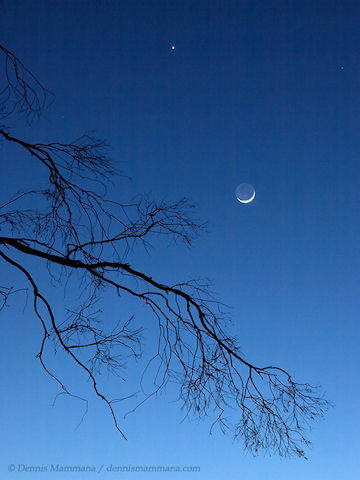NEW AND IMPROVED: Turn your iPhone or iPod Touch into a field-tested global satellite tracker. The Satellite Flybys app now works in all countries. | | | ATLANTIS-ISS, DOCKED: Space shuttle Atlantis has docked to the International Space Station (ISS), forming a bright and busy ensemble of two spacecraft. Sky watchers everywhere should be alert for ISS-Atlantis flybys of on Sunday evening. WEEKEND SKY SHOW: This weekend, Venus amd the Moon are inconjunction, beaming together through the sunset on both Saturday and Sunday evenings. Last night, Dennis Mammana photographed the display from Borrego Springs, California: 
"The Moon appeared about 4o below the bright planet Venus at dusk," says Mammana. "Although the Moon is officially in a crescent phase, sky watchers could easily see the outline of the full moon, which was illuminated by Earthshine--sunlight reflected back to the moon from the Earth itself. It was Leonardo da Vinci who first explained this beautiful phenomenon." It will be on display again tonight. Look west at sunset! more images: from Michel Renaud of Laval Observatory, Quebec, Canada; from Ken Jennings of Seoguipo, Jeju Island, South Korea; from Dale Nosko of Edmonton, Alberta, Canada; from Mark Staples at Little Lake Santa Fe, Florida; from Wienie van der Oord of Eastern Negev esert, Israel; from Joseph Shaw of Bozeman, Montana; from Bryan White of Denver, Colorado; from Richard Sass of Cloudcroft, New Mexico; from Adrian New of San Antonio, Texas;
May 2010 Aurora Gallery
[previous Mays: 2008, 2005, 2004, 2003, 2002] [aurora alerts] | 
